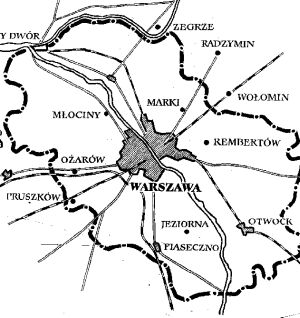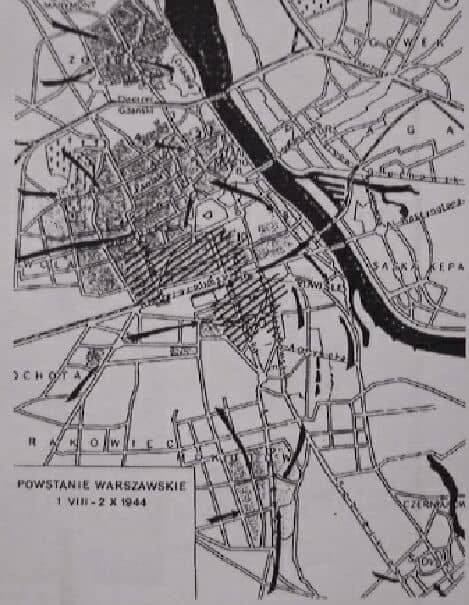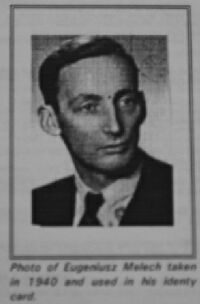Contents
PLEASE NOTE: The published, printed version, has all the proper Polish alphabetic letters used. In this Internet web site version, all such letters were changed to their English simplified characters. These letters are the lower and upper cases for a, c, e, l, n, o, s, and z.
Also, please note that the writer includes a wealth of names of participants with streets and addresses. However, he used only first names and the first letter of the last names throughout. While we were preparing the manuscript for publication, he tried to remember those last names and where he did they are included. The typed manuscript was also proofread and reviewed by members of the Polish press before final publication. Eugenuisz died in February 1997, but we did have five years of collaboration to give you an inside view of the real happenings that occured during those eventful days in Warsaw.
INTRODUCTION - The Warsaw Uprising re-visited
A capsule look at the troubled times within Poland during World War II. A short discussion of how the diary came to be, and why it was written in English. (Please note that only the portion of the book dealing with the Warsaw Uprising is included on the website. There is much more of historic value, expecially in the area of Pinsk, now in Belarus, at the beginning of the Soviet's occupation, and the author's trials and tribulations in escaping. The time frame is from 1 September 1939, until the uprising.)
PART I - The Warsaw Uprising of 1944
The Beginning
Here is revealed the inner feelings of the Warsavians (as they liked to be called). The hopes are present for a real freedom from the German occupation. The Russians are just outside Warsaw. But, the Warsavians do not like the Russians either. But, what they hope for is an ultimate return to their own government, the government that is in London. The diary entries are filled with expectations, and a short fight with the help of the incoming Russians.
The Early Days & Early Victories
The author was a field correspondent for the various underground publications of the day. He was able to get around the field of battle in Warsaw with his identity papers. He interviewed German prisoners and the insurgents. He still had his short-wave radio in his apartment to listen to Radio London, and others. He was well informed of the events surrounding him and of those that he was listening to (Albeit, today much of the talk on the radio then was surely propaganda). The feeling of help from English and American bombers was ever present.
The Waiting and the Standoff
Here, the author relates many of the beginning fears of the insurgents. Why had the Russians not come to their help. Why had the Russian airplanes not come to the air. Why had not the Americans and the English come as they promised to support the Poles in promises made in 1939? The diary is highly emotional and shows much of the earlier frustrations of the Warsavians. In just a month of fighting, the German garrison of about 30,000 men which could easily (according to the author) have been beaten by a joint insurrection and Russian action, grew to many hundreds of thousands of Germans. The main body came from the retreating Germans, Germans who would have been transferred to the Western front.
The Last Holdout and Hope for Help
The battle to free Warsaw from the Germans continues, but as the author sees more and more German aircraft and the big mortars falling on the city, he wonders what is going to happen to him and his wife and friends. The various fighting insurgents in numerous areas throughout Warsaw are holding on, but just barely. The great advances and accomplishments during the early days of the insurrection are being eaten away by the constant bombardment of the Germans. He interviews captured Germans and reads one man's diary. Strange, the Germans are just as fearful as the Poles. Why then is there any fighting? Here is the freedom of Poles from the dreaded holding prisons, torture camps, and executions. The writings take a lot of "human" touch as the author discusses activities of his family and friends. Again, the waiting for the Americans and English bombers. There is some airlifting of fighting materials by the English and Americans; but they do not need rifles and bullets. They need heavy mortars, and weapons capable of killing tanks, and aircraft. Why, oh why don't we get the help we need? Why don't the hated Russians attack?
The Despair and Retreat
The emotional feelings run high. All is coming to an end. If anything were to be gained at all, it would have to be the Americans! The Russians let us down. The English have let us down! The Americans from Italy have let us down, but at least they tried. The use of Polish army forces in England and Italy have been used in the fighting of France and at Monte Cassino. The London short wave reports have kept the author informed of the battles. But, why do they not let the Polish soldiers parachute into Warsaw to fight and die for their own country. Why must they fight and die for others. That is no help to the Warsavians at this time. The destruction of the beautiful city of Warsaw is near complete. The city had been greatly restored after the 1939 destruction. Much of the historical center that survived 1939, was now just a pile of rubble. The author describes much of the destruction, seen as he scrambles around the city.�
The Failure and End of the Insurrection
The continuation of the downfall of Warsaw is described by the author by the various districts. The realization that there is no hope for help by the Russians or anyone else leaves a bad thought in the minds of those who must now fend on their own. The author describes about the roundups taking place, area by area, then street by street, then block of flats by block of flats. The cleaning up of the roads by large groups of conscripted working parties made up of women, children and the remaining older men of Warsaw. The younger, healthier men of Warsaw are already removed and transported to the west in Germany to work in factories. The author describes how he and his wife almost gave themselves up to the Germans. But at the last minute an air attack finally by the Russians, allowed them to hide out in safe quarters.
PART II - The aftermath
The Escape from Warsaw
The Germans ordered the complete evacuation of Warsaw. But, they were on the lookout for the insurgents, and when found would send them off to concentration camps. Many of these camps are described here by the author, based on his interviews with released prisoners and escapees. The remaining Warsavians were shipped to relocation centers in the west. The author describes the daily trials that he and his wife endure while attempting to reach safe havens south and west of Warsaw. He describes the railroad centers, roads and cities that they travel through. He describes the many contacts with people, non-Warsavians as well, who risk their lives to help them; both with supplies and escape. They finally arrive at their destination, hiding away with little food and no money.
The End of a Dream and Struggle for a Future Life
The author reflects on his past, sums up his present, and plans for his future. He begins a life of underground selling of traded goods, cutting down trees for firewood, dragging firewood for many kilometers, and scrounging the meager foods available to eat. The aftermath to the insurrection is one that is rarely reported in books. Here the author shows the way of life as he and others lived it during the turbulent struggle to keep from being collected by the Germans. Here, the people work together to make sure they will survive. When the Germans conscript workers to build the big ditch around Warsaw, they walk over 10 kilometers to the site, work 12 hours and walk the 10 kilometers back to their home. The Germans offer special considerations to anyone "enlisting" in a Polish regiment of the German Army to fight the hated Russians. The Germans are nice to non-Warsavians. But, they are all Poles. And the Poles do only what they are required to do to keep from being killed or imprisoned by the Germans.
PART III - The Survival
Settling in for the Future
The diary continues until the arrival of the Russians and the taking over of the Government, not by the London Government, but by the Lublin Government. However, the portion within this book ends with the arrival of the New Year 1945. There is a great look at the situation of the Warsavians from the time the insurrection ends until the year ends. As one reads this part of the diary, in relation to the others, the reader can well understand why the author felt impelled to hide the diary away out of sight, for fear that it could be used against him by the Russians and the new Polish Communist Government.
Lester P. Gideon
Od Autora -- The Preface
(For the Polish original text, see the published book.)

|

|
This map covers the area of Warsaw and its environs described in the book. |
This map shows the battle areas within the city of Warsaw and the advances and losses of the insurgents.
|
It was the matter of accident or good luck that I met being at that time in Poland doctor Lester Gideon, the American journalist (publisher), now retired and
still fond of computers.
We became and remained good friends. It was one of the main reasons that I told Lester the story about my participation in the Warsaw Insurrection
(1944) as a war correspondent, and the writing of my diary in English; which detailed the events of those heroic days.
Lester showed himself to be a careful listener. At very first the moment, when he looked through my personal diary, he stated: "This is historic document",
and decided to publish it. Lester was very detailed in his questions and that was why I told him the following story.
First of all, I mentioned about my secret foreign language (English) lessons. I had them at Warsaw from January 1943 until 1 August 1944, the beginning
of the Insurrection. My lessons were given by professor Mary Badowska, aged and nobly teacher. She found that I was much better in writing than
speaking. This stimulated me to start (remember it happened during war time) to write about some events in Poland as well as abroad. These writings
were then check by my teacher.
However, it was not so simple; or it could be that Mary Badowska had been expressing her well-understood objections -- the fear about both our lives.
If the Germans caught me with these papers, we would be sent to the concentration camp and, in the consequence, killed.
I solved the problem as follows: My teacher had puppy named "Czapitko", and a charming canary bird that sang during our lessons. Mrs. Badowska
lived on the second floor, Wilcza Street. Because it was difficult for her to go down the stairs, I would take "Czapitko" for a walk to Marszakowska
street to buy canary food.
Upon my return, my text had been already carefully checked.
I created my diary usually during nighttime using carbide lamp. The story about how the diary had been kept in the cellar at Nowy Swiat 22 street, is to be
found by the reader in the diary itself.
It was not my intention to write the diary, but decision had been taken after the outbreak of insurrection and the main aim was to propagate text to next
generation. However, the II world war ended in 1945 only partly to the Polish People, since after the Germans, the occupation had been prolonged and
headed by the Soviets. I decided not to burst out with my diary till nowadays. This took 45 years.
I would like to remind that it was good luck that I met Lester. And thanks to him, an American reader could learn part of the history of the Polish People
whose heroism and sacrifice are unparalleled.
Thanks to God I have been able to take part in this heroic, struggle, survive and be witness of the Polish People's other battle for freedom, started by our
independent Trade Union "Solidarno" in 1980.
This is "Solidarno" which conduced to the downfall of the most total and inhumane system -- the communism.
On the occasion of publishing my diary I would like to express my deepest thanks to my friend doctor Lester Gideon for his labor, efforts and good
understanding.
Eugeniusz M E L E C H

This work is dedicated to my lovely grandson, Tomek Melech, now 15 (1992), as to taking example of these 63 heroic days could learn the real love to the Homeland and that is always worth to lay down one's life for it, when if that be the matter of highest values and
aims.

|
 |
 So, Let's get
on to the next section So, Let's get
on to the next section
Just click on the arrow
|
Updated 22 June 2002






 So, Let's get
on to the next section
So, Let's get
on to the next section